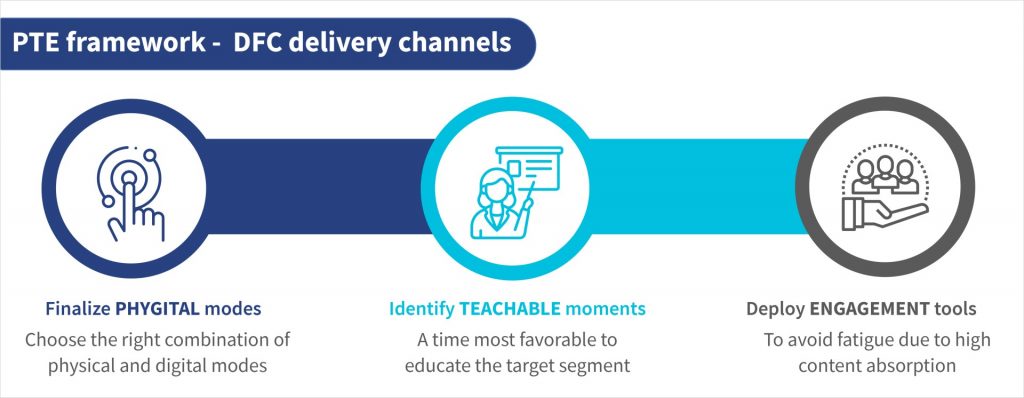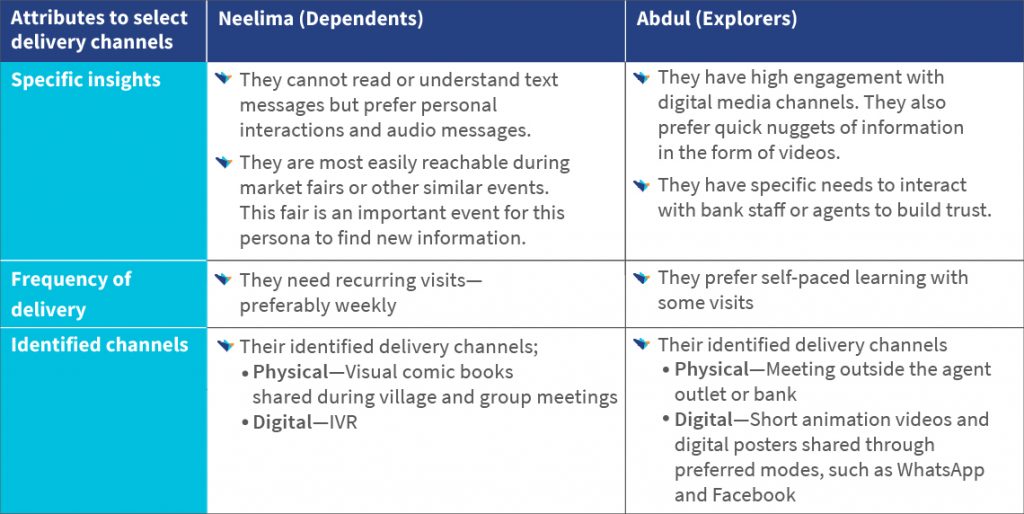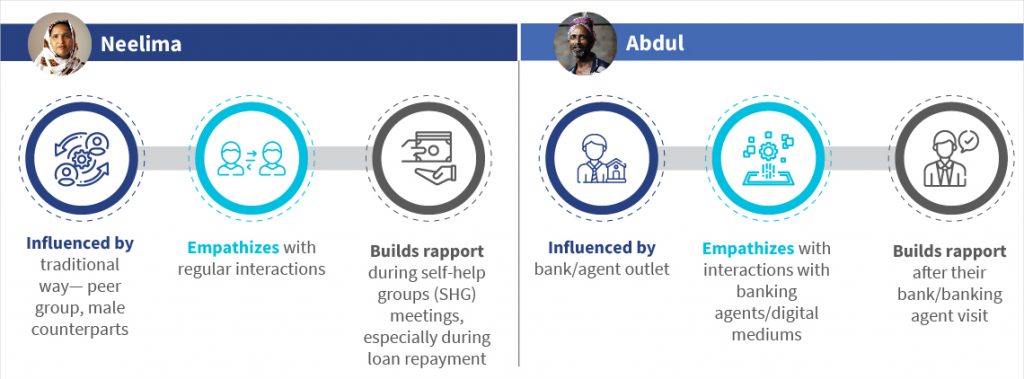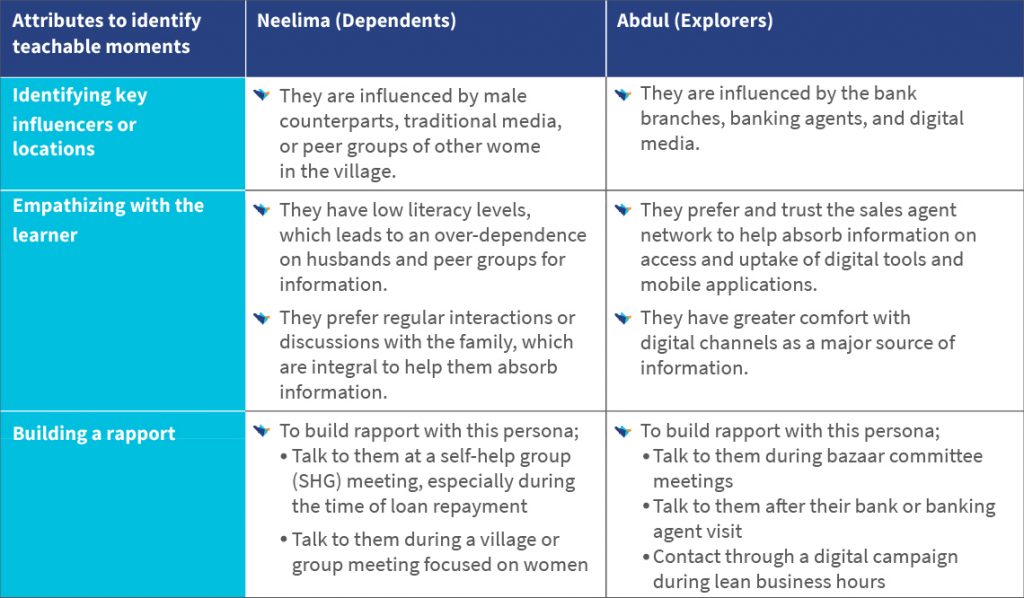Digital financial capability—revealing teachable moments through phygital (physical + digital) channels
by Surbhi Sood and Ritika Sah
May 23, 2023
5 min
This blog sheds light on tailoring delivery channels to maximize the impact of digital financial capabilities (DFC) content. It introduces personas and the phygital, teachable, and engagement or PTE framework. Read on to learn how we can enhance the adoption of DFC content through the integration of physical and digital channels and the use of teachable moments and interactive tools.
Part 1 of this blog series, “Digital financial capability—using emotions to design content,” explores how DFC (digital financial capability) content design can help address people’s fear of using DFS. The blog explores the use of emotions to design the DFC solution’s content to help users absorb content better to use DFS effectively. Yet content is just one part of the DFC solution design—the other critical part is the delivery channel. We explain this second part of the DFC puzzle through two personas—Neelima (Dependents) and Abdul (Explorers).
Figure 1: Two personas with different financial traits
Homemaker Neelima depends extensively on trusted sources for financial advice, such as her husband and women from her village. She does not own a mobile phone and uses her husband’s phone to call or listen to music. She feels intimidated at the bank branch and takes her husband along when she visits the bank agent to learn about new products or services.
Unlike Neelima, Abdul is a microentrepreneur who depends extensively on his business network for financial advice. He is an active smartphone user who uses it to keep himself updated on business news. He prefers to visit the bank branch or agent for information on new products and services but has almost no time in his busy schedule. While the DFC content for both personas may remain the same, the mode and delivery vary based on how well each persona can access the device, consume digital content, and use DFS.
This blog discusses the need to identify and customize delivery channels to share DFC content efficiently with specific target groups—through the phygital, teachable, and engagement (PTE) framework. Practitioners can use the PTE framework to identify the most effective delivery mechanism to increase DFC content’s adoption among various groups.
Figure 2: The PTE framework
While designing the DFC program’s delivery, we must seek clarity on three integral elements:
I. Identifying the right combination of phygital modes: A suitable variety of physical and digital modes must be included to deliver content based on the geography and target group.
II. Identifying teachable moments: A teachable moment is the most favorable time to educate the target group when they are most conducive to learning and absorbing content.
III. Deploying suitable engagement tools: Engagement tools are a simple technique to prevent content consumption fatigue.
I. Identifying the right combination of phygital modes
The delivery design should include broader channels to deliver content, such as physical and digital training. We must identify the channels best suited to the geography and the persona. The in-person model is effective but expensive and not adequately scalable. In contrast, the digital model is low-cost and highly scalable but low on effectiveness. Learners tend to drop out because of low engagement.
In contrast, phygital models that combine physical and digital are effective, scalable, and cost-effective. MSC delivers DFC content by identifying the right combination of phygital channels. In an earlier engagement, MSC implemented a phygital delivery model for the host community for UNCDF in Tanzania, combining phygital approaches. The program covered 30,000 refugees with different content absorption abilities to enhance their financial capabilities. Likewise, our current approach recommends various delivery channels for both personas based on their preferences (as shown in Figure 3).
Figure 3: Different delivery channels for different personas—Neelima (Dependents) and Abdul (Explorers)
Table 1: The different delivery channels for Neelima and Abdul
II. Identifying the teachable moments
A teachable moment is a time that is best suited to educate the target learners. A person is most likely to learn and absorb information during these moments. Teachable moments for financial services mainly arise when one discusses DFS or does a DFS transaction.
A study by the International Journal of Science and Research suggests if we wish to identify teachable moments, we must:
a. Identify key influencers, locations, and moments of action and choice;
b. Empathize with the learner by understanding their enablers and barriers; and
c. Build a rapport to behave like a friend so that the exchange of information happens at an emotional level.
Figure 4: Teachable moments to deliver DFC content for different personas Neelima (Dependents) and Abdul (Explorers)
Table 2: The teachable moments for Neelima and Abdul
III. Deploy suitable engagement tools
Using simple and engaging techniques in activities is essential for participants to absorb the content quickly. MSC designed a communication toolbox that enables bank agents to promote products effectively to low- and medium-income users. We suggest deploying engagement tools while delivering this DFC content in several formats, as outlined in the following graphic:
Figure 5: Engagement tools to deliver DFC content
- Quizzes: Motivate learners to remember the content they covered; learners can take quizzes to assess what they learned through IVR, calling, or other digital modes.
- Experiential learning: Use prototypes or simulations to engage the personas by allowing them a safe environment to make mistakes.
- Collaterals: Attract learners with posters and infographics to communicate important information.
- Peer learning: Build engagement groups to enable peer learning and network building; develop learner-centric local cohorts to provide human interaction.
- Gamification: Gamify progression across modules to motivate the learners through rewards, certification, mentorship opportunities, etc.
We suggest a mix of engagement tools for each persona, as outlined in the following graphic:
Figure 6: Engagement tools to deliver DFC content for different personas Neelima (Dependents) and Abdul (Explorers)
Besides these tools, developers of DFC programs can also include more such activities. The choice of activities will depend on the participants’ persona and intervention budget.
Conclusion
Designing effective DFC solutions demands the creation of suitable content alongside the identification and customization of the delivery channels to cater to specific target groups. This blog emphasized the importance of customizing the channel for different target groups using the PTE (phygital, teachable, and engagement) framework. Through the PTE framework, practitioners can identify the most conducive delivery mechanisms to increase the adoption of DFC content to effectively address the fear of using DFS among people. Overall, designing an effective DFC program requires a combination of content and delivery channel design, focusing on creating a customized delivery model that fits the target audience’s preferences and needs.
* Surbhi and Ritika are part of MSC’s training arm Helix Institute at MSC, which specializes in developing capability development content for end-users and supply-side providers.
Written by

 by
by  May 23, 2023
May 23, 2023 5 min
5 min








Leave comments